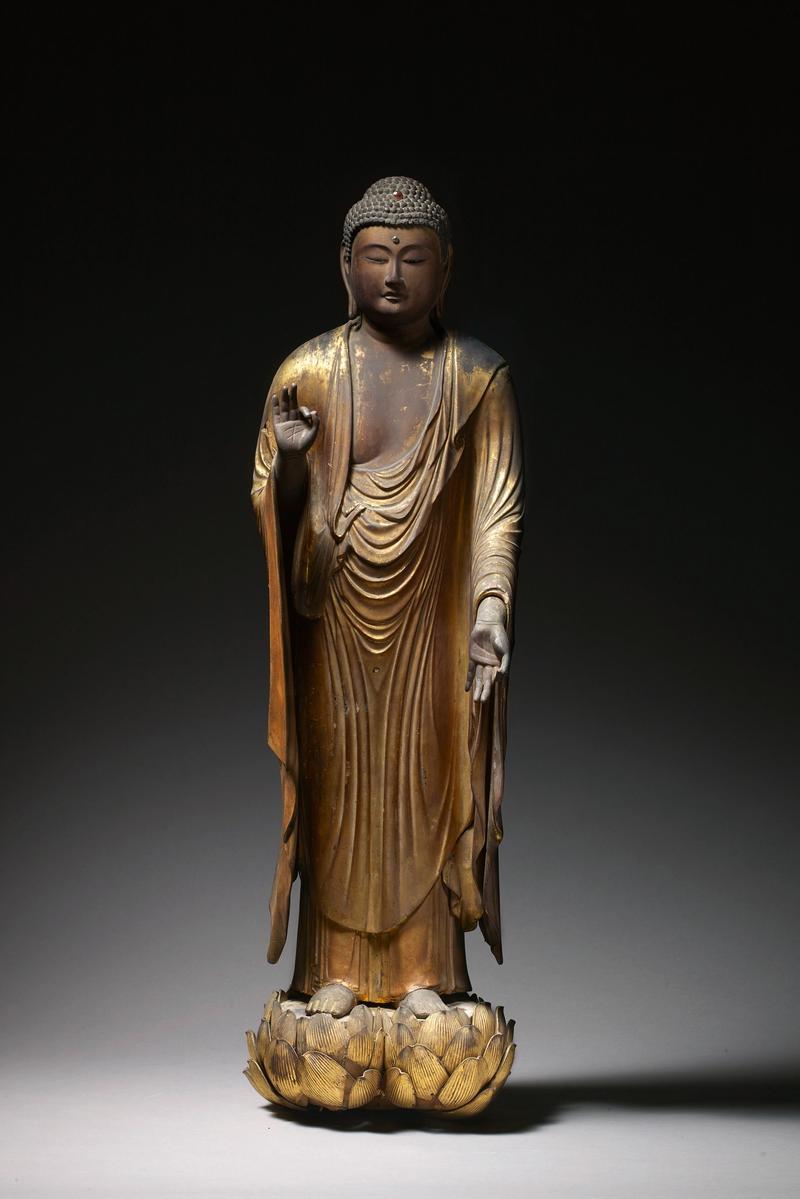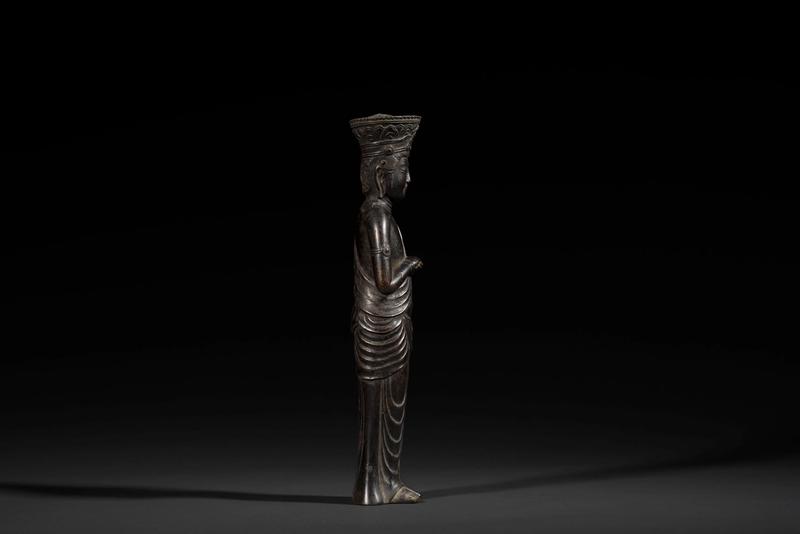A gilt bronze figure of Kannon Bosatsu (Bodhisattva) in the Zenkoji-style with the hands clasped in front of the chest and the head adorned with a crown decorated with flowers
Japan 14th century Kamakura/Nambokucho period
Dimensions: H. 34cm x W. 8.5cm x D. 6 cm (13½” x 3¼” x 2¼”)
Accompanied by an old collection label inscribed:
Kannon-bosatsu ryuzo (Standing figure of Bodhisattva)
Do-zo tokin (Gilt bronze)
Kamakura jidai (Kamakura period)
This Kannon Bosatsu belongs to a group of images modelled after the original triad of Amida and two attendants held at Zenkoji temple, Nagano prefecture.
The original triad has always been treasured and was designated as hibutsu (hidden Buddhas or secret Buddhas) and withheld from public view from the year 654 A.D. The practice of concealing important Buddhist icons is a concept unique to Japan and is thought to date back to at least the 7th century. Some hibutsu are put on public display for specific short periods, but some are never unveiled, this practice is known as zettai hibutsu (“absolute” hidden Buddhas) and the Zenkoji triad is one of them. In the Kamakura period, a replica of this original triad was made as an alternative devotional image however this version is also hibutsu and is only unveiled once every seven years for viewing at the same temple. The original triad of Zenkoji temple is allegedly the oldest Buddhist image in Japan and was a gift to the Japanese Emperor Kinmei (509-571) from Seong (d. 554), the 26th king of Baekje, one of the Three Kingdoms of Korea. During the Kamakura and Muromachi periods momentum for returning to the origin of Buddhism was at its peak and numerous Zenkoji-style Amida triads were produced in bronze, most of them coming from the Kanto area near modern day Tokyo.
According to Fuso Ryakuki (an anthology of historical records compiled in the Heian period), the central Amida Nyorai figure is approximately 45cm high and the two attendant figures were approximately 30cm high. The mudra of each attendant, holding both hands almost horizontally in front of the chest, is very specific to this particular representation. The two attendants, Kannon Bosatsu and Seishi Bosatsu, are almost identical and it is not easy to distinguish one from the other. However occasionally there are slight differences such as the images shown on the crowns (a small Amida for the Kannon and a ewer for the Seishi) although such differences are not always visible as sometimes both attendants were cast from the same mould.
Kannon personifies compassion and is one of the most widely worshipped Buddhist divinities in Japan. The name Kannon, meaning ‘watchful listening’ is the shortened version of the original title, Kanzeon, meaning ‘the one who constantly surveys the world listening for the sounds of suffering’.
According to Pure Land Buddhism the task of Kannon, Bodhisattva of mercy (Sanskrit: Avalokiteshvara), is to witness and listen to the prayers and cries of those in difficulty in the earthly realm and to help them achieve salvation. The Lotus Sutra teaches that one will be granted immediate salvation by intently reciting Kannon’s name to ask for guidance. The three major sutras of Pure Land Buddhism describe Kannon’s descent to meet dying devotees as the principal attendant Bodhisattva of Amida Buddha, along with Seishi Bosatsu.
Veneration of Kannon began in Japan in the late 6th century, soon after Buddhism had been introduced by way of China and Korea. In both painting and sculpture Kannon’s crown is often adorned with a small image of Amida (a kebutsu) as in this figure, symbolising Kannon’s role as Amida’s principal attendant. Kannon is one of the most popular modern deities in Japan’s Pure Land sects and serves various functions including protecting the Six Realms of Karmic Rebirth, acting as patron of motherhood and children, and protecting the souls of infants lost during childbirth.
For other examples of Zenko-ji style Buddhist sculptures see:
Suzuki Tsutomu ed., Ketteiban Mihotoke no kokoro Nihon no Butsuzo [Definitive edition, Buddha’s spirit: Buddhist figures in Japan], (Tokyo, 1979), p. 177 (Enkakuji temple collection, Kanagawa; dated 1271; Important Cultural Property)
Victor Harris and Ken Matsushima, Kamakura: The Renaissance of Japanese Sculpture 1185-1333, (British Museum, London, 1991), no. 38 (Seikoji temple collection, Chiba; dated 1300; Important Cultural Property)
Asia Society Museum ed., Kamakura: Realism and Spirituality in the Sculpture of Japan, (New Heaven and London, 2016), p.128-129, no. 37 (John C. Weber Collection, JS05)
Buddhist Art

A kakemono with the monk Hōnen

A kakebotoke

Zenkoji Kannon Bosatsu

Buddhist wood panels

A wood figure of Amida Nyorai, Heian/Kamakura period

Kakebotoke of Bishamonten

Dainichi Nyorai

Amida Buddha

Daiarakan (Sacred Arhat)

Jizō Bosatsu

Amida Buddha

A silk kakemono with Kannon

An iron nyoi

Zushi with Kannon

A bronze kakebotoke of Kannon



















